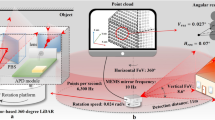Abstract
By installing omnidirectional measurement light detection and ranging (LiDAR) on a mobile robot, it is possible to acquire the surrounding environment. However, not all measurement areas of LiDAR can be used because of laser rays blocked by the robot’s body. Hence, in this research, the authors aim to expand the measurement area of LiDAR by installing mirrors at the blocked area to improve an ability of acquiring information regarding the front environment. The installation position and mirror angle can be determined from the desired area to be measured and the geometrical condition of the laser rays reflecting on the mirror. Moreover, based on the method, the robot enabled the collection of the surface information of stairs during stair climbing, which was typically difficult to gather.
Access this chapter
Tax calculation will be finalised at checkout
Purchases are for personal use only
Similar content being viewed by others
References
Abiko, S., Sakamoto, Y., Hasegawa, T., Yuta, S., Shimaji, N.: Development of constant altitude flight system using two dimensional laser range finder with mirrors (2017). https://doi.org/10.1109/AIM.2017.8014121
Endo, D., Watanabe, A., Nagatani, K.: Stair climbing control for 4-DOF tracked vehicle based on internal sensors. J. Robot. (2017). https://doi.org/10.1109/SSRR.2016.7784286
Guo, J., Shi, J., Zhu, W., Wang, J.: Approach to autonomous stair climbing for tracked robot. In: 2017 IEEE International Conference on Unmanned Systems (ICUS), pp. 182–186 (2017). https://doi.org/10.1109/ICUS.2017.8278337
Lee, H., Chung, W.: Terrain classification for mobile robots on the basis of support vector data description. Int. J. Precision Eng. Manufact. 19(9), 1305–1315 (2018). https://doi.org/10.1007/s12541-018-0154-4
Noguchi, H., Handa, M., Fukui, R., Mori, T., Sato, T., Sanada, H.: Capturing device for dense point cloud of indoor people using horizontal LIDAR and pan rotation of vertical LIDAR with mirrors. In: IEEE/SICE International Symposium on System Integration (SII), pp. 428–433 (2012)
Ohno, K., Tadokoro, S., Nagatani, K., Koyanagi, E., Yoshida, T.: Trials of 3-D map construction using the tele-operated tracked vehicle kenaf at disaster city. In: 2010 IEEE International Conference on Robotics and Automation, pp. 2864–2870 (2010). https://doi.org/10.1109/ROBOT.2010.5509722
Quigley, M., Conley, K., Gerkey, B., Faust, J., Foote, T., Leibs, J., Wheeler, R., Ng, A.Y.: Ros: an open-source robot operating system. In: ICRA Workshop on Open Source Software, vol. 3, p. 5. Kobe, Japan (2009)
Sinha, A., Papadakis, P.: Mind the gap: detection and traversability analysis of terrain gaps using LIDAR for safe robot navigation. Robotica 31, 1085–1101 (2013). https://doi.org/10.1017/S0263574713000349
Transport Ministry of Land I, (MLIT) T (2014) Efforts to take a far-sighted vision of social infrastructures. http://www.mlit.go.jp/common/001063080.pdf
Westfechtel, T., Ohno, K., Mertsching, B., Hamada, R., Nickchen, D., Kojima, S., Tadokoro, S.: Robust stairway-detection and localization method for mobile robots using a graph-based model and competing initializations. Int. J. Robot. Res. 37(12), 1463–1483 (2018). https://doi.org/10.1177/0278364918798039
Acknowledgements
Mitsubishi Heavy Industries supported this work.
Author information
Authors and Affiliations
Corresponding author
Editor information
Editors and Affiliations
Rights and permissions
Copyright information
© 2021 Springer Nature Singapore Pte Ltd.
About this paper
Cite this paper
Matsubara, K., Nagatani, K. (2021). Improvement in Measurement Area of Three-Dimensional LiDAR Using Mirrors Mounted on Mobile Robots. In: Ishigami, G., Yoshida, K. (eds) Field and Service Robotics. Springer Proceedings in Advanced Robotics, vol 16. Springer, Singapore. https://doi.org/10.1007/978-981-15-9460-1_7
Download citation
DOI: https://doi.org/10.1007/978-981-15-9460-1_7
Published:
Publisher Name: Springer, Singapore
Print ISBN: 978-981-15-9459-5
Online ISBN: 978-981-15-9460-1
eBook Packages: Intelligent Technologies and RoboticsIntelligent Technologies and Robotics (R0)




